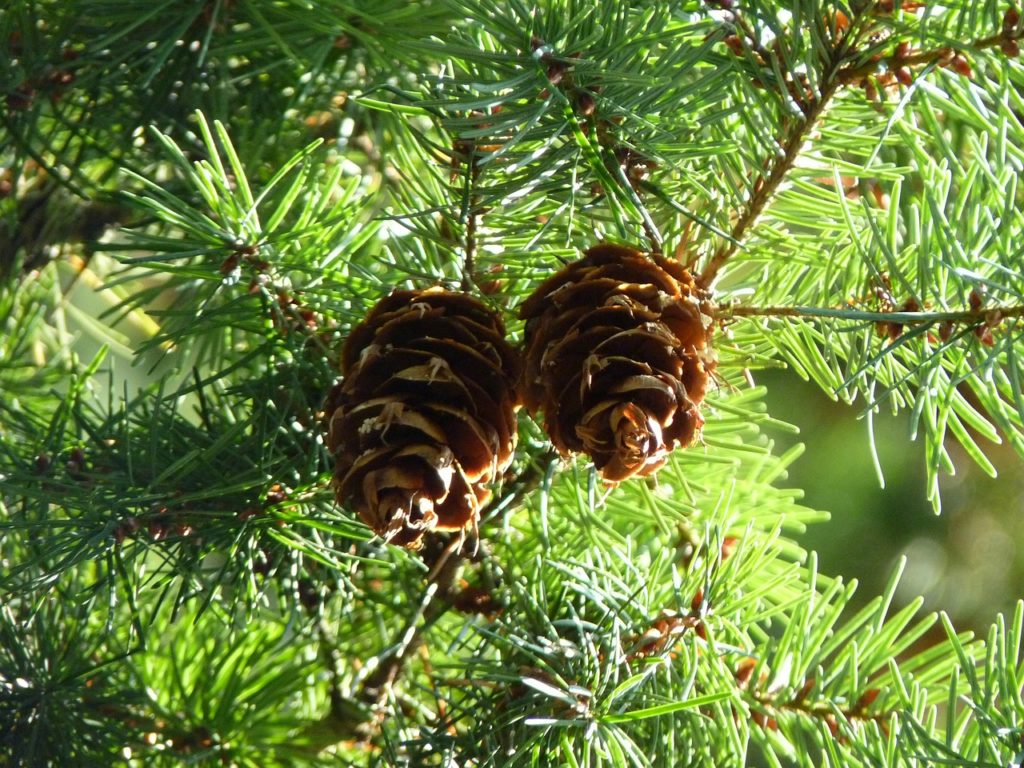This is the second of a two part series on Douglas-fir cultivars.
Introduction
Since its introduction to cultivation in 1826, Douglas-fir has become one of the world’s most popular trees. A variety of cultivars have been developed, and are available for purchase in nurseries and garden centers across the United States, Europe, and Canada. The following examines some of the most frequently selected varieties, including‘Glauca’, ‘Graceful Grace’, ‘Little Jon’, ‘Loggerhead’, ‘Nana Compacta’, ‘Pendula’, ‘Revoluta’, and ‘Stairii’.
‘Glauca’: ‘Glauca’, also called Rocky Mountain Douglas-fir and Interior fir, is a naturally occuring form of Douglas-fir. This selection is compact, with branches that grow upright. ‘Glauca’ is a large tree, reaching 35 to 50 m in height, and 1 m in diameter. It develops at a slow rate. The needles are gray-green to blue-green. ‘Glauca’ is hardier than most selections. It can grow in a wide variety of climatic conditions, enduring a multitude of different soil types and environments.
‘Graceful Grace’: ‘Graceful Grace’ is a frequently selected cultivar of Douglas-fir. It was first discovered by Albert Ziegler in York County, Pennsylvania in 1969. Ziegler named the cultivar after his wife, Grace. The tree is extolled for its weeping form, and elegant, drooping branches. It has long, dark green needles that drape over the stem, creating a lush appearance. ‘Graceful Grace’ is a hardy, vigorous cultivar that is ideal for planting in landscape settings. It can measure up to 40 feet in height, and 20 feet wide.
‘Little Jon’: ‘Little Jon’ is an appealing, conical shaped dwarf cultivar. It grows at a slow to medium rate, eventually reaching heights of up to 12 feet, with a 10 foot spread. When young, the shrub is globular, with dense foliage on small branches. The needles are flat, soft, and thin. They appear light green in spring, before slightly darkening. ‘Little Jon’ Douglas-fir should be planted in locations with full sun, and moist, well-drained soil.
‘Loggerhead’: ‘Loggerhead’ Douglas-fir is a slow growing dwarf cultivar with a spreading form. It typically measures 3 to 6 feet tall, with an 8 foot spread. The shrub’s branch structure is similar to that of Bird’s Nest spruce. The needles are a soft green, and fragrant. ‘Loggerhead’ Douglas-fir should be planted in areas with abundant sunlight, and moist, well-drained soil.
‘Nana Compacta’: ‘Nana Compacta’ is a dwarf cultivar of Douglas-fir with an appealing conical growth habit. The shrub can reach a height and width of 8 to 10 feet. It has blue to green needles that are flat, thin, and stiff. This cultivar is vulnerable to wind damage. It does best when planted in locations with full sun and moist, slightly acidic soil.
‘Pendula’: ‘Pendula’, also referred to as Weeping Douglas-fir, is a small tree with cascading branches, and a main trunk that spirals upwards. It develops at a medium rate. When mature, the tree can reach up to 40 feet in height, with a spread of 10 feet. Tbe needles are a deep blue-green. The tree’s fine texture makes it easily distinguishable from other cultivars. While the tree is hardy, it requires full sunlight, and moist, well-drained soil for optimal growth.
‘Revoluta’: ‘Revoluta’ is a cultivar of Douglas fir that is notable for its curled foliage, and pyramidal growth habit. Its needles are green, and spiral outwards. The tree develops at a medium rate, reaching heights of 15 to 25 feet, with a 5 to 10 foot spread. It is best suited for planting locations with full sun, and moist, well-drained soil.
‘Stairii’: ‘Stairii’ Douglas-fir is a pyramidal cultivar with variegated needles. Initially, the needles are colored yellow to white. They turn green in fall. ‘Stairii’ Douglas-fir is a fast growing cultivar, quickly reaching heights of 20 to 30 feet, with a 5 to 10 foot spread. It is subject to injury from heavy winds. Plant this cultivar in landscapes exposed to full sun, with moist, well-drained soil.
Photo courtesy of CC-by-2.0


